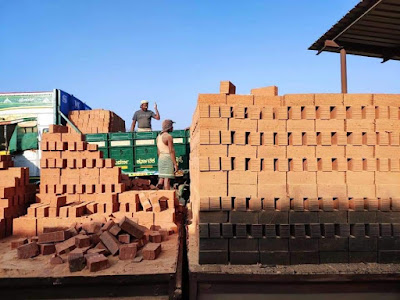Bricks are the structural units used as building materials which are being manufactured with the help of clay.
Clay is considered to be the most important raw material for manufacturing of bricks. The purest clay consists of Kaloinite with small quantity of minerals such as quartz, mica, felsar, calcite and magnesite.
The bulk specific gravity of clay bricks use to range from 1.6-2.5 .
Bricks are widely used because of the ease of clay availability, its low cost and the portability due to its shape and size.
Now we will see the classifications and the types of bricks
Classification of bricks / Types of bricks
Two types of Clay bricks are there such as
- Unburnt Bricks
- Burnt Bricks
Unburnt Bricks
These bricks are also known as sun-burnt bricks since they are dried under the sun light. The strength of these bricks are considerably low if we compare them with burnt bricks.
The prepared in 3 stages such as, Firstly the clay is prepared for the brick, than they are been put inside the mould and lastly they are dried under the sun for about 3-10 days.
Burnt Bricks
These bricks are most widely used for Brick Masonry these days. they are prepared inside the Kiln
Burnt bricks are distributed in 5 stages which will be discussed as.
First Class Bricks
- Weight of standard brick is 3000g.
- Water absorption should be 12-15% of its dry weight when is immersed in cold water for 24hrs.
- Crushing strength should not be less tha 10.5 N/mm2.
- The property of this brick is perfect definition for good brick.
- They are table moulded & they are well burnt inside Kiln.
- The colour of these bricks are - deep red, cherry or copper colour.
- The surface use to be smooth and rectangular with sharp straight edges and square corners.
- They are free from flaws, cracks and stones.
- No impression should be left on them such as finger nails.
- A Metallic or ringing sound should come when the bricks are strike against each other.
- Mostly used for Flooring, Reinforced brickwork, exposed face work in masonry structures.
Second Class bricks
- The properties are similar to First class Bricks.
- They are ground moulded and burnt in kilns.
- Little higher water absorption than first class is shown i.e 16-20% .
- Small cracks ad distortions can be seen.
- Crushing strength should not be less than 7 N/mm2
- Used for - Important and unimportant hidden works.
Third Class bricks
- These bricks are gound moulded and burnt in clamps .
- They are under burnt.
- They are soft and light coloured.
- They produce dull sound.
- Water absorption is about 25% .
- Its crushing strength lies between 3.5 N/mm2 to 7 N/mm2 .
- Used for - Building temporary structures.
Fourth Class Bricks
- These are oven burnt bricks.
- They are badly distorted in shape & size and are brittle in nature.
- These bricks are used for foundation/floors in lime concrete & road metals.
Heavy- Duty burnt clay bricks
- They are similar to burnt clay bricks and have same size, but have high compressive strength.
- They are distributed in different class based on there compressive strength such as
Class 400 -
Compressive strength should be between 40 N/mm2 to 45 N/mm2
Class 450 -
Compressive strength should be greater than 45 N/mm2
Water absorption should be less than 10%
Bulk density should be less than 2500 kg/m3


No comments:
Post a Comment